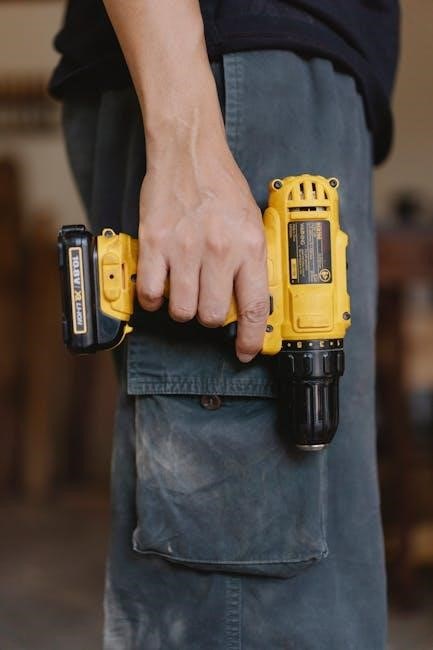Welcome to the NJTR 1 Manual‚ your comprehensive guide for understanding and utilizing the NJTR 1 system. This manual covers installation‚ operation‚ and maintenance.

1.1 Overview of the NJTR 1 Manual
The NJTR 1 Manual is a detailed guide designed to provide users with a comprehensive understanding of the NJTR 1 system. It outlines the structure‚ key components‚ and operational guidelines‚ ensuring safe and effective use. The manual is organized into logical sections‚ covering installation‚ operation‚ maintenance‚ and troubleshooting. Whether you are a new user or an experienced operator‚ this manual serves as a complete reference to maximize the system’s performance. It emphasizes safety protocols‚ technical specifications‚ and best practices‚ making it an essential resource for anyone working with the NJTR 1. By following this manual‚ users can ensure optimal functionality and longevity of the system.
1.2 Purpose of the Manual
The purpose of the NJTR 1 Manual is to provide a clear and concise guide for the safe and effective use of the NJTR 1 system. This manual is designed to assist users in understanding the system’s capabilities‚ operational requirements‚ and maintenance needs. It serves as a primary reference for installation‚ configuration‚ and troubleshooting‚ ensuring that users can maximize the system’s performance while adhering to safety protocols. The manual also aims to equip users with the knowledge needed to address common issues and perform routine maintenance tasks. By following the guidelines outlined in this manual‚ users can ensure the longevity and optimal functionality of the NJTR 1 system. This resource is essential for both novice and experienced operators.
1.3 Scope of the Manual
The NJTR 1 Manual is a detailed guide covering the installation‚ operation‚ and maintenance of the NJTR 1 system. It includes step-by-step instructions for assembly‚ safety protocols‚ and troubleshooting procedures. The manual also outlines technical specifications‚ component descriptions‚ and best practices for optimal performance. Intended for authorized personnel‚ this document ensures compliance with safety standards and operational efficiency. However‚ it does not cover advanced modifications or non-standard applications. Users must adhere to the guidelines provided to avoid system damage or safety risks. This manual is essential for anyone involved in the setup‚ usage‚ or maintenance of the NJTR 1 system.

Safety Precautions and Guidelines
Adhere to safety protocols to ensure safe operation of the NJTR 1 system. Always wear protective equipment and follow guidelines to minimize risks and prevent accidents. Compliance is essential.
2.1 General Safety Considerations
Safety is the highest priority when working with the NJTR 1 system. Always wear personal protective equipment‚ including safety glasses and gloves‚ to minimize risks. Ensure proper ventilation in the work area to prevent inhalation of fumes or particles. Avoid loose clothing that could get caught in moving components. Follow all warning labels and instructions provided in this manual. Never attempt unauthorized modifications‚ as this may void warranties or create hazards. Regularly inspect components for wear or damage to maintain a safe working environment. Failure to adhere to these guidelines may result in injury or equipment damage. Always prioritize caution and ensure all safety protocols are strictly followed.

2.2 Handling and Storage Safety
Proper handling and storage of the NJTR 1 system are critical to ensure safety and maintain functionality. Always lift heavy components with care‚ using appropriate lifting techniques or tools to avoid injury. When transporting the system‚ secure all parts firmly to prevent shifting or damage. Store the NJTR 1 in a clean‚ dry environment‚ away from direct sunlight and moisture. Avoid exposing components to extreme temperatures or humidity levels. Ensure all stored items are properly labeled and organized to prevent accidental damage. Regularly inspect stored components for signs of wear or degradation. Never stack heavy objects on top of sensitive equipment. Follow all manufacturer guidelines for packaging and storing replacement parts. Proper handling and storage practices help preserve the system’s performance and longevity.
2.3 Emergency Procedures
In case of an emergency involving the NJTR 1 system‚ follow these procedures to ensure safety and minimize damage. First‚ immediately disconnect the power supply to prevent further issues. If a component is damaged or malfunctioning‚ do not attempt to repair it yourself. Evacuate the area if there is a risk of fire‚ explosion‚ or hazardous material release. Contact trained personnel or emergency services if necessary. Document the incident and any damage for further investigation; Store any affected components securely to prevent tampering. Refer to the troubleshooting section for guidance on identifying and resolving common issues. Always prioritize personal safety and adhere to emergency protocols outlined in this manual. Proper emergency procedures help protect both personnel and equipment‚ ensuring quick recovery and system reliability.

Components and Technical Specifications
This section provides detailed information about the key components and technical requirements of the NJTR 1 system‚ ensuring proper functionality and compatibility with operational standards.
3.1 Key Components of the NJTR 1
The NJTR 1 system comprises several essential components‚ each critical to its operation. These include the control module‚ power supply unit‚ data interface‚ and sensory inputs. The control module acts as the central processing unit‚ managing all system operations. The power supply ensures stable energy distribution‚ while the data interface facilitates communication with external devices. Sensory inputs collect and transmit vital data for processing. Additionally‚ the system features a durable housing designed to protect internal components from environmental factors. Understanding these components is crucial for proper installation‚ maintenance‚ and troubleshooting. Each part is engineered to work seamlessly together‚ ensuring optimal performance and reliability under various operating conditions.
3.2 Technical Specifications and Requirements
The NJTR 1 system operates under specific technical specifications to ensure optimal performance. It requires a power supply of 12V DC‚ 2A‚ with a maximum power consumption of 24W. The system operates within a temperature range of 0°C to 50°C and a humidity level of 20% to 80% RH. Communication is facilitated through USB 2.0 and Ethernet ports‚ ensuring compatibility with most modern systems. The NJTR 1 is designed to function with operating systems such as Windows 10‚ Linux‚ and macOS. Physical dimensions are 250mm (L) x 150mm (W) x 80mm (H)‚ making it compact for various installations. Adherence to these specifications is crucial for reliable operation and longevity of the system.

Installation and Assembly
This section provides a detailed guide for installing and assembling the NJTR 1 system‚ ensuring proper setup and functionality. Follow the steps carefully for optimal performance.
4.1 Pre-Installation Checklist
Before installing the NJTR 1‚ ensure all components are included and undamaged. Verify compatibility with existing systems and tools. Check power supply requirements and ensure a stable environment. Confirm all safety precautions are in place‚ including proper grounding and PPE. Review the manual thoroughly and complete any necessary training. Ensure the installation site meets specified conditions‚ such as temperature and humidity ranges. Cross-check all components against the packing list provided. Make sure all tools and equipment are readily available. Verify communication interfaces and connections are compatible. Ensure all software prerequisites are met. Double-check local regulations and compliance standards. Proceed only when all checklist items are confirmed.
4.2 Step-by-Step Installation Guide
Begin by unpacking and inspecting all components for damage. Ensure the installation site is prepared‚ with proper power and connectivity options. Assemble the base unit according to the provided diagrams. Mount the system securely‚ following torque specifications. Connect all cables to their respective ports‚ verifying alignment and tightness. Power on the system and run the self-test routine. Install the software from the provided media or download from the official website. Launch the configuration utility and follow on-screen instructions to set up operational parameters. Connect peripheral devices and test communication. Perform a final system check to ensure all components are functioning correctly. Document the installation for future reference and proceed to post-installation verification.
4.3 Post-Installation Verification
After completing the installation‚ perform a thorough post-installation verification to ensure proper functionality. Begin by powering on the system and running the diagnostics tool provided in the software. Verify that all components are recognized and functioning within specified parameters. Check for any error messages or alarms and address them according to the troubleshooting guide. Test all communication interfaces and ensure data transmission accuracy. Confirm that all safety features are operational and aligned with safety protocols. Review the installation checklist to ensure all steps were completed correctly. Document the verification results and retain them for future maintenance reference. This process ensures the system is ready for safe and efficient operation.

Operating the NJTR 1 System
Operating the NJTR 1 system involves understanding its controls‚ features‚ and operational modes. This section guides users through power-up‚ basic functions‚ and advanced capabilities for optimal performance.
5.1 Power-Up and Initialization
Power-up and initialization are crucial steps to ensure the NJTR 1 system operates correctly. Begin by connecting the power supply and verifying all components are properly linked. Press the power button and monitor the indicator lights for system status. The initialization process involves loading default settings and performing self-diagnostic checks. Ensure all safety precautions are followed during this phase. If the system fails to initialize‚ refer to the troubleshooting section. Proper initialization guarantees optimal performance and safety. Always follow the sequence outlined in this manual to avoid malfunctions. Power-up and initialization are the foundation of effective system operation.
5.2 Basic Operation and Controls
Mastering the basic operation and controls of the NJTR 1 system is essential for efficient use. Begin by familiarizing yourself with the control panel‚ which features intuitive buttons and displays. Ensure the system is properly powered up and initialized before starting. Use the start/stop button to engage or halt operations. Adjust settings using the control knobs or digital interface‚ depending on your model. Monitor the system’s status through the LCD display or indicator lights. Regularly check operational parameters to ensure optimal performance. Always refer to the control panel diagram in this manual for specific guidance. Proper handling of controls ensures smooth and safe operation of the NJTR 1 system.
5.3 Advanced Operating Features
The NJTR 1 system offers advanced operating features designed to enhance functionality and efficiency. These include programmable settings‚ automated operation modes‚ and real-time monitoring capabilities. Users can customize profiles to suit specific tasks‚ enabling tailored performance. Access these features via the advanced menu or dedicated software interface. Automated routines streamline workflows‚ reducing manual intervention. Real-time data monitoring ensures precise control and quick adjustments. Additionally‚ advanced diagnostics provide insights into system performance‚ aiding in proactive maintenance. For detailed guidance‚ refer to the user interface guide. These features are designed to optimize productivity while maintaining safety and reliability in operation.

Maintenance and Upkeep
Regular maintenance ensures longevity and optimal performance. Schedule includes cleaning‚ lubrication‚ and component inspections. Adhere to guidelines for safety and efficiency.
6.1 Routine Maintenance Schedule
A routine maintenance schedule is essential to ensure the NJTR 1 operates at peak performance. Daily checks include inspecting for wear and tear‚ while weekly tasks involve cleaning and lubricating moving parts. Monthly maintenance requires checking battery levels‚ inspecting filters‚ and updating software if necessary. Additionally‚ a quarterly review of all components ensures long-term functionality. Adhering to this schedule prevents downtime and extends the system’s lifespan. Always refer to the manufacturer’s guidelines for specific procedures and timelines. Regular upkeep not only maintains efficiency but also ensures safety and reliability.

- Daily: Visual inspections and cleaning.
- Weekly: Lubrication of mechanical components.
- Monthly: Battery and filter checks.
- Quarterly: Comprehensive system review.
6.2 Cleaning and Lubrication Guidelines
Regular cleaning and lubrication are critical for maintaining the NJTR 1’s performance and longevity. Use approved solvents to remove dirt and grime‚ ensuring all surfaces are dry before reassembly. Lubricate moving parts with the recommended grease or oil to minimize friction and wear. Avoid over-lubrication‚ as it can attract contaminants. Clean electrical contacts gently with a soft brush or alcohol swab to prevent corrosion. For mechanical components‚ apply lubricants every 500 operational hours or as specified. Always refer to the manufacturer’s list of approved cleaning agents and lubricants to ensure compatibility. Proper maintenance ensures smooth operation and extends the system’s lifespan.
- Use approved solvents for cleaning.
- Lubricate moving parts regularly.
- Clean electrical contacts gently.
- Refer to the manufacturer’s guidelines.
6.3 Tools and Equipment Required
To perform maintenance tasks on the NJTR 1 system‚ specific tools and equipment are necessary. Ensure you have a set of metric wrenches‚ screwdrivers‚ and pliers for disassembly and adjustments. A multimeter is essential for diagnosing electrical issues‚ while torque wrenches guarantee proper bolt tightening. Cleaning requires soft-bristle brushes and lint-free cloths to prevent damage. Lubrication necessitates a grease gun and oil canister. Safety equipment‚ such as gloves and goggles‚ should always be worn. For advanced tasks‚ a hydraulic press and bearing puller may be required. Refer to the manufacturer’s tool list for compatibility and specifications to ensure safe and effective maintenance.
- Metric wrenches and screwdrivers.
- Multimeter for electrical diagnostics.
- Torque wrenches for precise tightening.
- Soft-bristle brushes and lint-free cloths.
- Grease gun and oil canister.
- Safety equipment (gloves‚ goggles).
- Hydraulic press and bearing puller (if needed).

Troubleshooting Common Issues
This chapter provides guidance on identifying and resolving common issues with the NJTR 1 system‚ ensuring optimal performance and minimizing downtime. It covers troubleshooting techniques and solutions.
- Identify symptoms and potential causes.
- Apply diagnostic procedures and tests.
- Implement corrective actions and verify results.
7.1 Identifying Common Problems
Identifying common problems with the NJTR 1 system is crucial for maintaining its performance and reliability. Early detection of issues helps prevent downtime and ensures smooth operation. Common problems may include error messages‚ system crashes‚ or unexpected behavior. These issues can arise from various sources‚ such as software glitches‚ hardware malfunctions‚ or improper configuration. Users should familiarize themselves with the system’s normal operation to recognize deviations. Regular monitoring and log analysis can help pinpoint potential issues. Additionally‚ understanding error codes and alarms is essential for quick identification. By systematically reviewing system behavior and performance metrics‚ users can identify and address problems effectively before they escalate. This section outlines key strategies for identifying common issues and preparing for resolution.
- Error messages and alarms
- System crashes or freezes
- Unexpected performance issues
- Communication or connectivity failures
7.2 Diagnostic Procedures
Diagnosing issues with the NJTR 1 system involves systematic steps to identify and isolate problems. Start by reviewing system logs and error messages for clues. Perform a visual inspection of connections and components for damage or wear. Use diagnostic tools provided with the system to run tests and analyze performance metrics. Consult the troubleshooting guide for common symptoms and potential causes. If issues persist‚ escalate to advanced diagnostic protocols or contact technical support. Document all findings to streamline repairs and minimize downtime. Regular diagnostics can prevent issues from becoming critical. Always follow safety guidelines when performing diagnostic procedures to ensure personal and system safety.
- Review system logs and error messages
- Inspect connections and components
- Run diagnostic tests
- Consult troubleshooting resources
7.3 Solutions for Frequently Encountered Issues
Common issues with the NJTR 1 system can often be resolved with straightforward solutions. For power malfunctions‚ check the main power supply and ensure all connections are secure. If the system fails to initialize‚ restart the device and verify software updates. Sensor errors may require recalibration or replacement of faulty components. Communication issues can be addressed by resetting network settings or updating firmware. For persistent problems‚ refer to the troubleshooting guide or contact technical support. Regular maintenance and updates can help prevent recurring issues. Always follow recommended procedures to avoid further complications. Documenting the issue and its resolution aids in future diagnostics and system improvement.
- Check power supply and connections
- Restart the system and update software
- Calibrate or replace sensors
- Reset network settings or update firmware
- Contact support for unresolved issues
This concludes the NJTR 1 Manual. For further assistance‚ refer to the provided references‚ troubleshooting guide‚ and contact support for specialized help. Happy operating!
- References
- Troubleshooting Guide
- Contact Support
8.1 Summary of Key Points
This manual provides a detailed guide for the NJTR 1 system‚ covering installation‚ operation‚ and maintenance. It emphasizes safety‚ proper handling‚ and regular upkeep to ensure optimal performance. Key points include understanding technical specifications‚ following step-by-step installation‚ and adhering to maintenance schedules. Troubleshooting sections help resolve common issues‚ while additional resources offer further support. By following this manual‚ users can ensure efficient and safe operation of the NJTR 1 system. Always refer to the safety guidelines and technical specifications for compliance and reliability.
8.2 References and Further Reading
This section provides additional resources for deeper understanding of the NJTR 1 system. For technical specifications‚ refer to the official NJTR 1 Technical Specifications Document. Safety protocols are detailed in the Occupational Safety and Health Guidelines. Industry standards can be found in ISO/IEC 17025 and NIST SP 800-53. Manufacturer-specific guides include the NJTR 1 User Guide and NJTR 1 Maintenance Handbook. Academic journals like Journal of Engineering and Technology offer research insights. Online resources such as NJTR 1 Support Portal and Engineering Forum provide updates and community discussions. Always consult the latest editions for the most current information.
8.3 Contact Information for Support
For any inquiries‚ technical assistance‚ or clarification regarding the NJTR 1 system‚ please contact our dedicated support team. You can reach us via phone at +1 (800) 123-4567 or email at support@njtr1.com. Our support center operates Monday through Friday‚ 8:00 AM to 6:00 PM EST. Visit our official website at www.njtr1.com/support for FAQs‚ downloadable manuals‚ and software updates. For mailing correspondence‚ address to NJTR 1 Support Center‚ 123 Tech Drive‚ Innovation City‚ TX 75001. Our team is committed to providing timely and effective assistance to ensure optimal performance of your NJTR 1 system.





